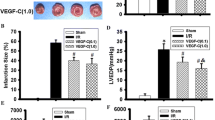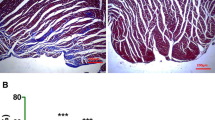Abstract
Angiogenic factor with G patch and FHA domains 1 (AGGF1) is a newly identified proangiogenic protein, which plays an important role in vascular disease and angiogenesis. However, its role in myocardial ischemia/reperfusion (I/R) injury remains unknown. This study investigated whether AGGF1 is involved in the pathogenesis of mouse myocardial I/R injury and the underlying mechanisms. Wild-type (WT) C57BL/6 J mice were treated at 30 min prior to I/R injury with anti-AGGF1 neutralizing antibody (3 mg/kg) or recombinant human AGGF1 (rhAGGF1, 0.25 mg/kg). After I/R injury, the infarct size, the number of TUNEL-positive cardiomyocytes, Bax/Bcl2 ratio, inflammatory cytokine expression and angiogenesis were markedly increased as compared with sham control. Treatment of WT mice with anti-AGGF1 neutralizing antibody resulted in exaggeration of myocardial I/R injury but reducing angiogenesis. In contrast, administration of rhAGGF1 markedly reversed these effects. Furthermore, anti-AGGF1- or rhAGGF1-mediated effects on I/R-induced cardiac apoptosis, inflammation and angiogenesis were dose dependent. In addition, the protective effects of AGGF1 on cardiomyocyte apoptosis and inflammation were confirmed in cultured cardiomyocytes after I/R. Finally, these effects were associated with activation of ERK1/2, Stat3 and HIF-1α/VEGF pathways and inhibition of activation of NF-κB, p53 and JNK1/2 pathways. In conclusion, we report the first in vivo and in vitro evidence that AGGF1 reduces myocardial apoptosis and inflammation and enhances angiogenesis, leading to decreased infarct size after I/R injury. These results may provide a novel therapeutic approach for ischemic heart diseases.








Similar content being viewed by others
Change history
06 November 2021
A Correction to this paper has been published: https://doi.org/10.1007/s10495-021-01695-9
References
Hosoda T, Kajstura J, Leri A, Anversa P (2010) Mechanisms of myocardial regeneration. Circ J 74:13–17
Eefting F, Rensing B, Wigman J, Pannekoek WJ, Liu WM, Cramer MJ et al (2004) Role of apoptosis in reperfusion injury. Cardiovasc Res 61:414–426
El-Menyar AA (2008) Cytokines and myocardial dysfunction: state of the art. J Card Fail 14:61–74
Armstrong SC (2004) Protein kinase activation and myocardial ischemia/reperfusion injury. Cardiovasc Res 61:427–436
Tabibiazar R, Rockson SG (2001) Angiogenesis and the ischaemic heart. Eur Heart J 22:903–918
Syed IS, Sanborn TA, Rosengart TK (2004) Therapeutic angiogenesis: a biologic bypass. Cardiology 101:131–143
Mitsos S, Katsanos K, Koletsis E, Kagadis GC, Anastasiou N, Diamantopoulos A et al (2012) Therapeutic angiogenesis for myocardial ischemia revisited: basic biological concepts and focus on latest clinical trials. Angiogenesis 15:1–22
Han Y, Yang K, Proweller A, Zhou G, Jain MK, Ramirez-Bergeron DL (2012) Inhibition of ARNT severely compromises endothelial cell viability and function in response to moderate hypoxia. Angiogenesis 15:409–420
Timur AA, Driscoll DJ, Wang Q (2005) Biomedicine and diseases: the Klippel-Trenaunay syndrome, vascular anomalies and vascular morphogenesis. Cell Mol Life Sci 62:1434–1447
Tian XL, Kadaba R, You SA, Liu M, Timur AA, Yang L et al (2004) Identification of an angiogenic factor that when mutated causes susceptibility to Klippel-Trenaunay syndrome. Nature 427:640–645
Fan C, Ouyang P, Timur AA, He P, You SA, Hu Y et al (2009) Novel roles of GATA1 in regulation of angiogenic factor AGGF1 and endothelial cell function. J Biol Chem 284:23331–23343
Li HH, Kedar V, Zhang C, McDonough H, Arya R, Wang DZ et al (2004) Atrogin-1/muscle atrophy F-box inhibits calcineurin-dependent cardiac hypertrophy by participating in an SCF ubiquitin ligase complex. J Clin Invest 114:1058–1071
Zheng W, Seftor EA, Meininger CJ, Hendrix MJ, Tomanek RJ (2001) Mechanisms of coronary angiogenesis in response to stretch: role of VEGF and TGF-beta. Am J Physiol Heart Circ Physiol 280:H909–H917
Zheng W, Christensen LP, Tomanek RJ (2004) Stretch induces upregulation of key tyrosine kinase receptors in microvascular endothelial cells. Am J Physiol Heart Circ Physiol 287:H2739–H2745
Xie P, Guo S, Fan Y, Zhang H, Gu D, Li H (2009) Atrogin-1/MAFbx enhances simulated ischemia/reperfusion-induced apoptosis in cardiomyocytes through degradation of MAPK phosphatase-1 and sustained JNK activation. J Biol Chem 284:5488–5496
Zhang Y, Zeng Y, Wang M, Tian C, Ma X, Chen H et al (2011) Cardiac-specific overexpression of E3 ligase Nrdp1 increases ischemia and reperfusion-induced cardiac injury. Basic Res Cardiol 106:371–383
Amaral SL, Maier KG, Schippers DN, Roman RJ, Greene AS (2003) CYP4A metabolites of arachidonic acid and VEGF are mediators of skeletal muscle angiogenesis. Am J Physiol Heart Circ Physiol 284:H1528–H1535
Besse S, Boucher F, Linguet G, Riou L, De Leiris J, Riou B et al (2010) Intramyocardial protein therapy with vascular endothelial growth factor (VEGF-165) induces functional angiogenesis in rat senescent myocardium. J Physiol Pharmacol 61:651–661
Yang K, Zhang TP, Tian C, Jia LX, Du J, Li HH (2012) Carboxyl terminus of heat shock protein 70-interacting protein inhibits angiotensin II-induced cardiac remodeling. Am J Hypertens 25:994–1001
Zhang Y, Kang YM, Tian C, Zeng Y, Jia LX, Ma X et al (2011) Overexpression of Nrdp1 in the heart exacerbates doxorubicin-induced cardiac dysfunction in mice. PLoS One 6:e21104
Li HH, Willis MS, Lockyer P, Miller N, McDonough H, Glass DJ et al (2007) Atrogin-1 inhibits Akt-dependent cardiac hypertrophy in mice via ubiquitin-dependent coactivation of Forkhead proteins. J Clin Invest 117:3211–3223
Wang L, Li YL, Zhang CC, Cui W, Wang X, Xia Y et al (2013) Inhibition of Toll-like receptor 2 reduces cardiac fibrosis by attenuating macrophage-mediated inflammation. Cardiovasc Res 101:383–392
Song L, Yang H, Wang HX, Tian C, Liu Y, Zeng XJ et al (2013) Inhibition of 12/15 lipoxygenase by baicalein reduces myocardial ischemia/reperfusion injury via modulation of multiple signaling pathways. Apoptosis 19:567–580
Lu Q, Yao Y, Yao Y, Liu S, Huang Y, Lu S et al (2012) Angiogenic factor AGGF1 promotes therapeutic angiogenesis in a mouse limb ischemia model. PLoS One 7:e46998
Hamacher-Brady A, Brady NR, Gottlieb RA (2006) The interplay between pro-death and pro-survival signaling pathways in myocardial ischemia/reperfusion injury: apoptosis meets autophagy. Cardiovasc Drugs Ther 20:445–462
Lopez-Neblina F, Toledo AH, Toledo-Pereyra LH (2005) Molecular biology of apoptosis in ischemia and reperfusion. J Invest Surg 18:335–350
Sano M, Minamino T, Toko H, Miyauchi H, Orimo M, Qin Y et al (2007) p53-induced inhibition of Hif-1 causes cardiac dysfunction during pressure overload. Nature 446:444–448
Song H, Yin D, Liu Z (2012) GDF-15 promotes angiogenesis through modulating p53/HIF-1alpha signaling pathway in hypoxic human umbilical vein endothelial cells. Mol Biol Rep 39:4017–4022
Kelly BD, Hackett SF, Hirota K, Oshima Y, Cai Z, Berg-Dixon S et al (2003) Cell type-specific regulation of angiogenic growth factor gene expression and induction of angiogenesis in nonischemic tissue by a constitutively active form of hypoxia-inducible factor 1. Circ Res 93:1074–1081
Pugh CW, Ratcliffe PJ (2003) Regulation of angiogenesis by hypoxia: role of the HIF system. Nat Med 9:677–684
Xu CW, Zhang TP, Wang HX, Yang H, Li HH (2013) CHIP enhances angiogenesis and restores cardiac function after infarction in transgenic mice. Cell Physiol Biochem 31:199–208
Li ZD, Bork JP, Krueger B, Patsenker E, Schulze-Krebs A, Hahn EG et al (2005) VEGF induces proliferation, migration, and TGF-beta1 expression in mouse glomerular endothelial cells via mitogen-activated protein kinase and phosphatidylinositol 3-kinase. Biochem Biophys Res Commun 334:1049–1060
Ushio-Fukai M, Alexander RW (2004) Reactive oxygen species as mediators of angiogenesis signaling: role of NAD(P)H oxidase. Mol Cell Biochem 264:85–97
Liu W, Schoenkerman A, Lowe WL Jr (2000) Activation of members of the mitogen-activated protein kinase family by glucose in endothelial cells. Am J Physiol Endocrinol Metab 279:E782–E790
Valdembri D, Serini G, Vacca A, Ribatti D, Bussolino F (2002) In vivo activation of JAK2/STAT-3 pathway during angiogenesis induced by GM-CSF. FASEB J 16:225–227
Osugi T, Oshima Y, Fujio Y, Funamoto M, Yamashita A, Negoro S et al (2002) Cardiac-specific activation of signal transducer and activator of transcription 3 promotes vascular formation in the heart. J Biol Chem 277:6676–6681
Niu G, Wright KL, Huang M, Song L, Haura E, Turkson J et al (2002) Constitutive Stat3 activity up-regulates VEGF expression and tumor angiogenesis. Oncogene 21:2000–2008
Acknowledgments
This work was supported by China National Natural Science Funds (No. 81025001, 81330003), Chang Jiang Scholar Program, and Beijing Higher Education Young Elite Teacher Project (YETP1668).
Conflict of interest
The authors declare that they have no conflict of interest.
Author information
Authors and Affiliations
Corresponding authors
Rights and permissions
About this article
Cite this article
Liu, Y., Yang, H., Song, L. et al. AGGF1 protects from myocardial ischemia/reperfusion injury by regulating myocardial apoptosis and angiogenesis. Apoptosis 19, 1254–1268 (2014). https://doi.org/10.1007/s10495-014-1001-4
Published:
Issue Date:
DOI: https://doi.org/10.1007/s10495-014-1001-4




